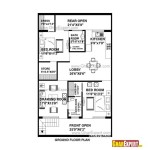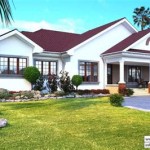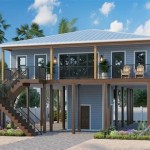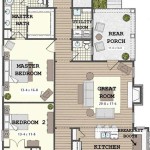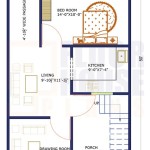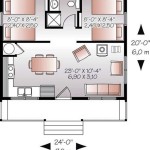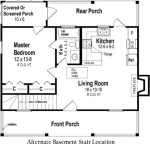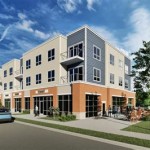American Foursquare House Plans: A Timeless Design
The American Foursquare, also known as the Prairie Box, is a distinct architectural style that gained popularity in the United States from the late 1890s through the 1930s. It emerged as a reaction against the ornate Victorian architecture that preceded it, offering a more practical and affordable housing option for the burgeoning middle class. The defining characteristics of the Foursquare house include its boxy shape, efficient use of space, and focus on functionality rather than elaborate embellishments. These features contributed to its enduring appeal and ensured its presence in neighborhoods across the country.
American Foursquare house plans were typically designed with a simple, symmetrical layout. This regularity made construction straightforward and cost-effective. The basic form is a two-and-a-half-story structure, often built on a square foundation, hence the name. The exterior is generally plain, with emphasis placed on clean lines and minimal ornamentation. Common materials used in construction included brick, wood siding, and stucco, reflecting the regional availability and preferences. The style represents a transitional period in American architecture, bridging the gap between the Victorian era and the Mid-Century Modern movement.
Understanding the key elements of American Foursquare house plans is crucial for appreciating their architectural significance and considering their suitability for contemporary living. The plans themselves are not static; they were adapted and modified to meet the needs of individual families and changing societal expectations. This adaptability is part of what contributes to the style's continued relevance.
Key Features of American Foursquare Architecture
Several features define the American Foursquare style and distinguish it from other architectural designs. These include the overall form, the interior layout, and the characteristic exterior elements that contribute to its visual identity. Examining these features provides a comprehensive understanding of what constitutes an American Foursquare house.
The defining characteristic of an American Foursquare house is its boxy, typically square shape. This geometry allows for efficient use of space, maximizing the square footage within a relatively small footprint. The two-and-a-half stories provide ample living space, typically including a full basement and an attic that may be finished or unfinished. This verticality contributes to its distinct proportions. The roof is typically a low-pitched hipped roof with wide eaves, often featuring dormers to provide natural light and ventilation to the attic space. This roof design offers protection from the elements and contributes to the overall aesthetic.
The interior layout of a Foursquare house is typically simple and functional, often based on a four-room floor plan on each level. The first floor typically includes a living room, dining room, kitchen, and often a front entry foyer or hallway. The second floor typically houses the bedrooms and a bathroom. This layout ensures efficient circulation and maximizes the use of space. Wide, open porches are another distinctive feature, often extending across the front of the house and providing a welcoming outdoor space. These porches served as social hubs and offered respite from the summer heat. The simplicity of the interior layout allows for flexibility in furnishing and decorating, making it adaptable to different lifestyles and preferences.
Exterior details, while relatively restrained compared to Victorian architecture, are still essential elements of the Foursquare style. A prominent central dormer, often with three windows, is a common feature, providing light and headroom to the attic. Window placement is typically symmetrical, reflecting the overall balance of the design. Windows are often double-hung and may feature decorative elements such as window grilles or stained glass. Wide eaves, supported by brackets or exposed rafters, are another characteristic detail, providing shade and protection from the elements. The front entrance is usually centered and may be emphasized with a small porch or decorative detailing. The use of materials, such as brick, wood siding, or stucco, also contributes to the overall aesthetic of the house. These materials are generally durable and low-maintenance, reflecting the practicality of the design.
Advantages of American Foursquare House Plans
The enduring popularity of American Foursquare houses can be attributed to several advantages that made them desirable to families in the early 20th century and continue to resonate with homeowners today. These advantages include affordability, efficient space utilization, and adaptability to various locations and lifestyles.
Compared to the more elaborate Victorian homes that preceded them, American Foursquare houses were significantly more affordable to build and maintain. The simple, boxy shape and standardized construction techniques reduced material costs and labor time. The efficient use of space meant that families could obtain a substantial amount of living area on a relatively small lot, further reducing overall expenses. The durable materials typically used in construction, such as brick and wood, also contributed to lower maintenance costs over the long term. The affordability of the Foursquare house made it accessible to a broader segment of the population, particularly the growing middle class. This accessibility contributed to its widespread adoption and enduring presence in American neighborhoods.
The efficient use of space is a hallmark of the American Foursquare design. The square footprint maximizes the interior living area, minimizing wasted space. The straightforward layout, with rooms arranged logically around a central hallway or staircase, ensures efficient circulation and easy access to all parts of the house. The two-and-a-half stories provide ample living space for families of various sizes, while the basement offers additional storage or potential for future expansion. The attic space, often unfinished, can be used for storage or converted into additional living space. This efficient use of space makes Foursquare houses ideal for those who prioritize functionality and practicality.
American Foursquare houses are remarkably adaptable to a variety of locations and lifestyles. Their simple design and unpretentious aesthetic allow them to blend seamlessly into diverse neighborhoods. The square footprint makes them well-suited for smaller urban lots, while the ample living space provides comfortable accommodations for families. The interior layout can be easily adapted to suit different needs and preferences, allowing homeowners to customize the space to their specific requirements. The exterior can be updated with modern materials and finishes without compromising the integrity of the original design. This adaptability has contributed to the Foursquare's continued relevance and popularity, allowing it to evolve and adapt to changing times.
Modifications and Modern Adaptations of Foursquare Plans
While the basic American Foursquare plan remains consistent, numerous modifications and adaptations have been introduced over the years to suit contemporary lifestyles and incorporate modern amenities. These modifications often involve changes to the interior layout, exterior detailing, and the addition of modern features. Understanding these adaptations is essential for appreciating the versatility of the Foursquare style and its ability to meet the needs of modern families.
One common modification involves opening up the interior layout to create a more open and flowing living space. This often involves removing walls between the living room, dining room, and kitchen to create a larger, more unified area. This open concept design is popular in modern homes and allows for better interaction between family members and guests. Another common modification is to enlarge the kitchen to accommodate modern appliances and features, such as islands, breakfast bars, and ample counter space. Bathrooms are often updated with modern fixtures and finishes, and additional bathrooms may be added to increase convenience. These interior modifications enhance the functionality and comfort of the Foursquare house, making it more appealing to modern homeowners.
Exterior modifications may include changes to the porch design, window placement, and the addition of new architectural elements. The original porch may be enclosed to create a sunroom or expanded to provide more outdoor living space. Windows may be replaced with energy-efficient models, and new windows may be added to increase natural light. Dormers may be enlarged or redesigned to improve attic ventilation and headroom. Exterior siding may be updated with modern materials, such as fiber cement or vinyl, to reduce maintenance requirements. Landscaping and exterior lighting can also be used to enhance the curb appeal of the house. These exterior modifications can significantly improve the appearance and functionality of the Foursquare house while preserving its essential architectural character.
Modern adaptations of American Foursquare plans often incorporate sustainable building practices and energy-efficient features. These may include solar panels, geothermal heating and cooling systems, rainwater harvesting systems, and energy-efficient windows and insulation. Green building materials, such as recycled wood and low-VOC paints, may also be used to reduce the environmental impact of the house. Smart home technology can be integrated into the design to improve energy efficiency and convenience. These modern adaptations allow homeowners to enjoy the classic charm of the Foursquare style while minimizing their environmental footprint and reducing their energy costs. By incorporating these features, the American Foursquare can continue to be a relevant and sustainable housing option for future generations.

An American Foursquare Story Four Square Homes House Plans Vintage

Chicago Vernacular Architecture

Modern American Homes Classic Foursquare C L Bowes 1918 Square House Plans Four

Traditional Four Square House Plan 50100ph Architectural Designs Plans

10 More Sears Foursquare Kit House Plans Part 2 Everyday Old

The Foursquare Past Present Everett Custom Homes

1925 Lewis Built Catalog Homes The Portland Square House Plans Four

Change Happens American Foursquare

Our House Plans Right Home Company

Frame Masonry Foursquare University Of Cky College Arts Sciences

